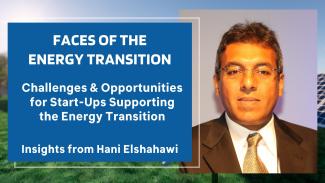
Insights by TechnologyCatalogue.com US Partner Hani Elshahawi
Start-ups have a key role in the Energy Transition as they develop and offer disruptive technologies that help decarbonise economies. They introduce solutions that digitise energy ecosystems, democratise power generation, better monitor and measure energy use, among others. Private and public sector investments are pouring into these young companies, a clear sign of their critical role both from economic and social perspectives.
Given the ability of startups to develop and deliver innovative solutions, how can we then maximise their potential to accelerate Energy Transition?
To give us insights as to how start-ups can fully contribute in achieving a more sustainable future, we invited our US partner Hani Elshahawi, a thought Leader, entrepreneur, and game changer, for an interview. Hani partners with innovators, academics, start-ups, investors, and customers to create impact and drive growth through integration, collaboration, digitalization, and education. He holds several patents and has authored over 150 technical publications.
Before establishing his own company NoviDigiTech.com, Hani was Deepwater Digitalisation Lead, GameChanger, and Formation Testing and Sampling Principal Technical Expert at Shell, where he spent a total of 18 years. Prior to that, he spent 15 years with Schlumberger in over 10 countries in Africa, Asia, and North America during which he has held various positions in interpretation, consulting, operations, marketing, and technology development.
Read Hani’s insights below.
1. What are the major priorities for businesses in the coming years that can serve as opportunities for start-ups?
Two areas are top of mind for most executives and for me as I work with start-ups, entrepreneurs and end-users: (1) ESG (Environmental, Social, and Governance) and (2) Digitalisation.
There is increasing attention on ESG, especially when it comes to finding solutions that are technology-driven. These are not just green or clean tech, which aim to reduce environmental impact via energy efficiency, more sustainable use of materials or environmental protection actions. These solutions also encompass what may be collectively termed as climate tech—a broader set of sectors which tackle the entire challenge of decarbonising the entire economy by the middle of the century. ESG in its latest manifestation also encompasses social equity, climate change, and sustainability at large.
Then, you have digitalisation. Over the last decade, digital has been upending industries across the board and has also made industry boundaries a lot more permeable than ever before. It has had deep impact on our lives and promises a future that is more data-driven, customer-centric and in many ways, more democratised. Although it is a relatively late comer, the energy industry has not been immune to these changes, especially post-COVID as has been the case for the pharmaceutical, biological and medical industries. In all of these, we saw a dramatic increase in the uptake of digital technologies over the last couple of years.
3. What are the roadblocks for innovators offering novel technologies to established markets?
One of the roadblocks is finding your way into an existing contractual framework in an industry or market, and one way to address that is to partner with an existing player that has secured contracts in the next many years but lacks novel technologies that can differentiate themselves from others.
Working with existing channel partners makes sense because it is rare for the value of a niche innovation to materialize without enabling a more holistic solution. Incumbent service companies are good at delivering business as is or with incremental improvements, whereas innovators are generally in the business disrupting the status quo. A partnership of the two can therefore result in a win-win proposition by strengthening the incumbent’s offerings whilst also broadening the innovator’s value proposition and customer base.
4. What kind of technological innovations are likely to be highly necessary and desirable for industries in light of strengthened sustainability calls?
Most ESG initiatives, particularly in the United States, have been focused around the environmental components of the equation to reduce flaring, water use and surface footprint. With Energy Transition in full force, these efforts need to be broadened. For example, the increased demand for the batteries and electronics used in electric vehicles will place greater stress on rare earth minerals such as lithium and cobalt. Access to those minerals is going to be key in the coming years, so we need technologies to improve extraction from existing waste streams and reuse.
There is also the need for designing for longevity. Typically, a lot of designs of infrastructure are only meant to deliver over their designed operating life with some safety factors built in. Abandonment or decommissioning are typically afterthoughts. That model needs to change to build with greater life-cycle sustainability in mind – i.e. design for longevity, repurposing, recycling, and reuse.
TechnologyCatalogue.com’s Faces of the Energy Transition blog series aims to shed light on key issues surrounding the global transition to clean energy. We invite thought leaders, industry players and members of the academe to share their insights on topics that are related to the Energy Transition.
If you have suggestions on topics and/or resource persons, feel free to reach out via email at community@technologycatalogue.com.
About NoviDigiTech
Founded by Hani Elshahawi, NoviDigiTech LLC (NoviDigiTech.com) is about Helping People & Powering Progress through Innovation, Digital Enablement, and Technical Excellence. We do that by partnering with innovators, academics, startups, entrepreneurs, investors, and customers to create impact and drive growth through integration, collaboration, digitalization, and education. Areas of expertise include Technology strategy, idea generation, customer discovery, design thinking, system integration, proof of concept/pilot testing, and commercial deployment.
Note: If you are a supplier, end-user or tech expert based in the US, you can reach out to Hani on how TechnologyCatalogue.com can assist you in your technology positioning or deployment and selection activities.
Subscribe to our Newsletter
Related Blogs

Innovation and Culture: A Closer Look at Large Energy Companies
To give us insights on the innovation culture in huge energy companies, we invited Jaco Fok, an innovation and digitalisation expert, for an interview. Here, he discussed extensively how large companies change/improve/maintain certain aspects of company culture to welcome innovation and successfully embed it in their organisation. He also noted key opportunities for oil and gas companies that are at the intersection of Energy Transition.

Innovation and the Fast-Changing Energy Sector by Dr. Robert Perrons
With the rapid technological changes in the sector coupled with sustainability being a central concern for the industry, we find it helpful to thresh out some of the key issues surrounding technology and innovation in the energy sector. In this blog you can read Dr. Robert Perrons' (professor of Technology Management and Strategy at the Queensland University of Technology) insightful answers to our questions on innovation in the energy sector.

Tech Startups in COVID times, Insights from Mina Kamel
To give us an idea of how tech startups are weathering the global pandemic, we invited Mina Kamel, CEO and one of the co-founders of Switzerland-based Voliro Airborne Robotics to talk with us.
